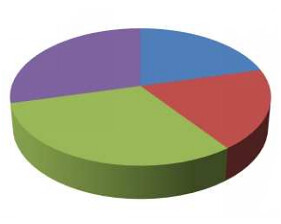The previous blog posts have highlighted the main structural materials and summarized where their environmental impacts come from. These posts are a summary of the ASCE publication, Structural Materials and Global Climate: A Primer on Carbon Emissions for Structural Engineers, which provides an in-depth summary of climate change science, the building industry’s role in climate change, and what structural engineers can do to reduce the environmental impacts of the built environment. This blog post focuses on Chapter 11: Examples from Structural Materials and Global Climate: A Primer on Carbon Emissions for Structural Engineers, and provides readers with guidance on how to calculate the embodied environmental impacts of a building, through life-cycle assessment (LCA).
The specific example in the publication, uses a screening LCA to calculate and compare the global warming potential (GWP) of three structural floor systems: (1) mild reinforced pan-formed concrete beams with post-tensioned concrete girders (2) two-way post-tensioned floor slab with “wide shallow” concrete beams (3) composite steel beams and composite concrete floor deck. The LCA’s scope consists of a floor system of a hypothetical office building approximately 29,000 ft2containing a stair and elevator core and modest architectural expressions at the building’s corners, see Figure 1. The floor system is designed to the following criteria:
- 50 psf live load
- 15 psf partition load
- 10 psf superimposed dead load
- Curtain wall load of 120 plf (10 psf w/ 12 ft-0 in. floor height)
- Minimum 1-hour floor rating
- No special consideration for floor vibrations
- Deflection criteria:
- span/240 total loads
- span/360 live loads
- Camber steel beams for 80% dead load, ¾ in. min. camber
The LCA considered only the GWP within the cradle-to-gate system boundary (stages A1-A3). See previous chapters in Structural Materials and Global Climate: A Primer on Carbon Emissions for Structural Engineers for details on the cradle-to-gate emissions coefficients. From each of the three floor system designs, a bill of materials was generated. The material quantities were multiplied by their GWP impact data, which are found in previous chapters in the publication, to determine the environmental impact of the floor system. Results are summarized in Table 1 below.
Item
|
GWP
(lbs CO2e / lb except where noted)
|
Pan Formed Beam
|
Post Tensioned Slab
|
Composite Steel
|
3500 psi concrete (yd3)
|
490 (lb /yd3)
(base mix)
|
0
|
0
|
455
|
5000 psi concrete (yd3)
|
734 (lb/yd3)
(base mix)
|
800
|
824
|
0
|
Rebar
|
0.90
|
125,000
|
64,000
|
2,420
|
Post Tensioning Strand
|
2.83
|
14,000
|
17,670
|
0
|
Metal Deck
|
2.19
|
0
|
0
|
68,000
|
Shear Studs
|
0.90
|
0
|
0
|
1,700
|
Welded Wire Reinforcement
|
0.92
|
0
|
0
|
8,500
|
Steel Shapes
|
1.15
|
0
|
0
|
166,000
|
Deck Closure
|
2.19
|
0
|
0
|
4,500
|
Table 1: Material quantities and GWP for all options
Of the systems explored, the composite steel floor system had the least GWP, see the full publication for the detailed results and for the limitations that apply to this study. Additionally, these results show where the biggest source of GWP is for each system, which allows for structural engineers to not only identify them but also to find ways to reduce these impacts. The example also explored the impact of using two different concrete mixes, a mix with 20% cement replacement and a mix with 40% cement replacement. In the full publication, readers can see that for this particular example a reduction in GWP of the floor system of approximately 15% can be achieved by just using the mix with more cement replacement.
A note to the readers, this example is not comprehensive. It is only looking at a building’s floor system and only considering life-cycle phases from “cradle-to-gate”. Additionally, the results only consider GWP, they do not compare the full set of impact categories as required by a life-cycle assessment standards. More and better data is needed to develop more sophisticated analyses in the future. The hope is that structural engineers will soon have more reliable and comparable figures for CO2e emissions that will give more credence to calculations such as these. The increase in EPDs developed and available to structural engineers is helping this. The committee is working with the mindful MATERIALS program to collect industry-wide EPDs from industry trade associations and EPD program operators to create a free resource for structural engineers. With these supply-chain-specific product carbon footprints, structural engineers could soon specify CO2e emissions as a performance metric to motivate and reward lower impact/higher efficiency manufacturing methods.















